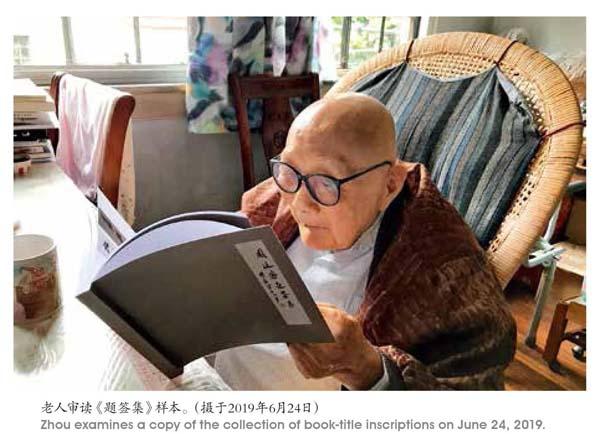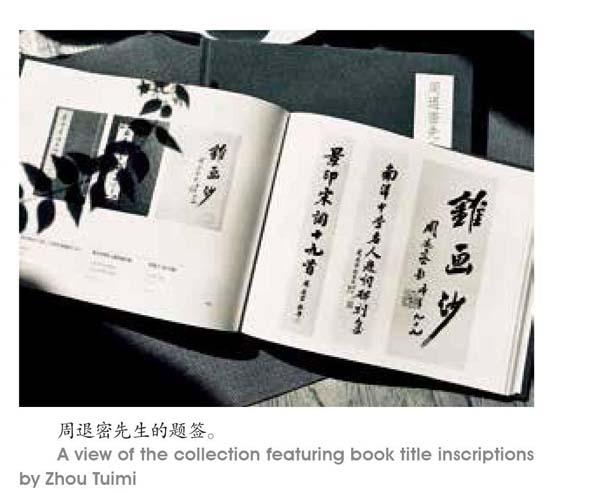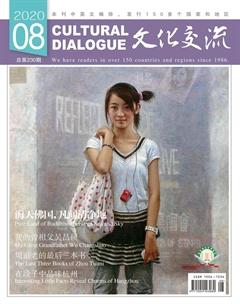周退老的最后三本书
沈迦



我提出把诗稿整理出来印本小书的想法。老人说:“谢谢你!”随后又补充了一句:“我的东西没意思,不值得收藏。我是三脚猫,不会抓老鼠的。”
2020年7月16日凌晨,著名学者、诗人、书法家周昌枢(别号退密)驾鹤仙游,其孙女周京女史次日发出一长文《他是这样走完一生的……》,罗列了祖父一生的著述,从1988年油印的第一本诗集《芳草集》开始,到今年春天印行的家族文献汇编《宁波湖西周家》,共计28种。最后3种:《立雪:宽斋藏周退密诗翰》《周退密先生题签集》及《宁波湖西周家》,都是“物外社”出品,我有幸经手。
余生也晚,虽早闻退老大名,也读过他的书、买过他的字,但一直无缘拜识,直到2012年秋,经海上名宿徐定戡先生哲嗣徐家祯老师的引荐,才有幸踏足老人晚年所居的安亭草阁。当时退老已近百岁,虽杜户封笔,但依然耳聪目明,聊起往事,记忆清晰。
十余年前,一偶然的機会淘到海上老辈画家沈迈士的一批旧藏,有书画、有诗札,其中最大宗的是退老写于20世纪七八十年代的一批诗稿,计41通47页,相当部分未收录于2011年黄山书社出版的《周退密诗文集》。沈迈士是退老1932年就读震旦大学预科时的老师,退老从此立雪程门,“谈画论诗五十年”。
2012年与老人认识后,我陆续带这批书画、诗札给他看。老人见到自己早年的诗作颇感慨,他说沈迈士晚年住复兴中路553弄1号,他当时则住31号,两人是一条弄堂里的邻居。这些唱和的诗稿就是那时送来送去的作品,“他住1号,巷口,我每天总要经过的,送上楼,或投在他家信箱里,有时也叫保姆送过去。他也经常自己送过來,他家不是总有保姆,晚年经济不好就没叫保姆了。”这些早年诗作退老自己没保存,没想到历经劫难的老师却将它留存起来。
我近年客居海外,回国机会不多,但每次回沪,都尽量去看望老人。清晰记得安亭草阁临窗的方桌前,上海早晨的阳光斑斑驳驳地洒进来,我与老人对坐,听他说那些陈年旧事。他经常说起沈迈士,还几次问我沈家后人情况。因了同姓,他相当长一段时间都误以为我与他的老师有亲戚关系。老人对老师感念甚多,特別对其在“文革”中的遭遇,屡有唏嘘。他说沈迈士是世家子弟,祖父沈秉成官至两江总督,父亲沈瑞琳、母亲龚韵珊均擅丹青。
2016年年初的一次见面,不知怎的又说起沈迈士及这批旧藏。我提出把诗稿整理出来,印本小书的想法。“既可让人欣赏到您的诗词、书法,又可增加人们对沈迈士先生的了解。”老人说:“谢谢你!”随后又补充了一句:“我的东西没意思,不值得收藏。我是三脚猫,不会抓老鼠的。”
获老人首肯,我即开始编辑笺释,半年后,将初稿彩色打印一册送呈审阅。老人花了几天时间通读全书,改出七八处差错,有的地方还加了注,以让我看得明白。递校稿给我时,他又说自己这些不成样子的东西,劳我如此费心费力,还打印得这么漂亮,要谢谢我。与老人交往多年,他每次说起自己的作品,不论是诗词还是书法,都很谦虚。
记得那天我们还对坐在窗前的方桌上商量了书名,我原题《宽斋存周退密诗翰》,他改“存”为“藏”。我又问书名请谁题签好?本来老人亲自题写是首选,但他说自己手已抖,写不成字了。他还笑说你自己写最好,现在前辈、平辈都没有了。
因居海外,这本书的编排多有拖沓,直至2017年秋才最后定稿,并交方兄韶毅主持的“物外社”印行。方兄在出版界游走多年,自己又是版本迷,他建议此书走文人雅玩性质的自印本路线,限量印制、小众流通。他还请了何天健设计装帧,鼓捣出了素色布面精装小开本样式,还分黄、蓝两色版本,真是既雅致又高冷。
这本小众读物2018年初印行后受到爱书者的追捧。退老远在澳洲的孙女周京见书后也给予赞扬,说这是“以爷爷名义面世的书里最漂亮的一本”。
对做书的人来说,有读者喜爱是最大的鼓励,于是萌发继续做点什么的念头。周退老擅书法,近几十年来为书刊题签甚多,编本《周退密先生题签集》很自然成为新的念想。2018年临近春节前的一个上午,我把这想法透露给老人,他颔首、微笑,并说“我们应是前生有缘了”。一百多岁的老人说与我“前生有缘”,一时有受宠若惊之感。我虽数学不好,但脑子里还是飞快地心算了下——他生于民国初年,前生应在嘉庆道光年间,那时我又在干嘛?
那天为提议出题签集,我特意带去一本中华书局新版的《启功先生题签集》,精装小开本,厚厚一册,很精美。退老捧读在手时直说启老字好,并夸书做得漂亮。我说您的字一样好,我会努力把您这本题签集也做得漂漂亮亮!
当时我问师母,退老写过的题签到底有多少?有清单吗?师母闻之笑,说写是写了很多,但家里什么也没有。老人性淡泊,平日随题随赠,不要说没有留底稿,连样书都没保存。
好在生逢网络时代,我于是在自己的微信公众号“遇见阿雅”上发起征集。2018年11月13日上传第一批几十种题签封面后,反响比预期热烈,不少人留言,提供图片或线索。后来我这小公号堪称周退老情报中心,各种题签纷至沓来。到2019年6月,已收集到142种,应该差不多了。
编辑这百多种题签时,我发现最早的书于1978年,为沈祖棻的《涉江诗稿》所题,最晚的书于2018年为《郑逸梅遗印集》所题。前后跨度竟然正好40年,完整覆盖改革开放的40年。这看似偶然,其实有必然。在该书的《编者小语》中,我这样写道:“如果没有改革开放,就不会有周老这批传统文化老人的复出;如果没有改革开放,就不会有因改革开放而成长起来的一批喜爱、保存并力图弘扬传统文化的人。当然,也只有继续改革开放,中国文化才会在未来显出更大的魅力与价值。”写这段话时,我是想起沈迈士的遭遇的。书印行后,有人认为我把风花雪月的书法题签与改革开放联在一起,故作高调。但陈子善老师读书后却在微博上称赞我这句话“真是深得我心”。
《立雪:宽斋藏周退密诗翰》已“立”在前,《周退密先生题签集》自然由方兄继续担任策划人,设计也由何天健兄操刀,他采取《立雪》的小开本,但改直式为横式,两书既成系列又显区别。装帧很成功,发行也很成功,500册除少量留赠作者、编者外几乎秒空。现在孔夫子旧书网上,有人标价3000元,出乎意料。
《題签集》印行前后,周京也通过我联系“物外社”,请为她参与主编的《宁波湖西周家》做设计。这是周氏家族文献汇编,其中有不少退老回忆先人、旧居、故乡的文章。
《宁波湖西周家》只印200册,不对外发售,但“物外社”待之如正规大书,装帧、印制都极讲究。书稿编排几经周折,最后清样并下厂已是2020年1月,农历年关不远。方兄亲自到厂督战,终赶在印刷工人年假前将书印出,并赶装了60本,于17日交付快递。老人收到书后赞精美,还分别给我们这3个经办人各题赠一册作纪念。周京发来她爷爷题签时的视频,107岁的老人已显吃力地在扉页上写字。3本书的题字,老人花了两天才完成。当时我人在广州,答应春节后返沪即登门取书并致谢。不料1月23日荆楚疫起,武汉封城,随后我也匆匆去国。更没想到的是老人前天突然下世,意外常比计划先来。
人间繁杂,老人退而仙游了。明天是追悼会,无法回沪送别,昨斟酌了一日,撰写了副挽联,嵌入“题签”、“立雪”、“物外”几字,记我们与老人的一段文字因缘,在他漫长人生的最后岁月,我们有幸参与了他最后3本书的编印工作。挽联由方兄亲笔手书,长逾八尺,以我们仨的名义,敬献在老人灵右:
题签百叶、题诗千叶、题书万叶,物寄怜文字,清和幽远江湖上;
立雪程门、立行苏门、立德孔门,外游啸云烟,散澹隐沦天地间。
2020年7月18日于温哥华
The Last Three Books of Zhou Tuimi
By Shen Jia
A scholar of Chinese classics, poet, calligrapher, and teacher of the French language, Zhou Tuimi (1914-2020) passed away on July 16, at the age of 107 (computed in the traditional Chinese way).
On July 17, his granddaughter Zhou Jing published a long obituary in commemoration of the scholars life journey. Listed in the obituary are 28 books published in his name. I was instrumental in publishing the last three. I had heard of the masters name and read his books and brought some of his calligraphic works into my collection before I met him for the first time in the autumn of 2012. That year, Zhou was nearly 100 years old. Though he was contented with not taking part in social affairs and not writing any more, he could see and hear clearly. His memory of the past was sharp.
A number of years before I met Zhou, I purchased at a second-hand market a batch of paintings, calligraphy works and poem manuscripts, which had been in the collection of Shen Maishi (1891-1986), an old-generation painter in Shanghai. Among the precious collectables were 47 pages of a manuscript of 41 poems in the handwriting of Zhou Tuimi. Many of them were not included in the published in 2011. Shen Maishi was a teacher under whom Zhou studied in a preparatory course of Aurora University, the predecessor of present-day Fudan University, in Shanghai in 1932. Their friendship lasted 50 years.
After I met Zhou in 2012, I brought the batch of paintings, calligraphic works and poems by Zhou to Zhou. He marveled at the resurfacing of these works. He said he and Shen Maishi were neighbors in the same lane not far from each other. They wrote poems to each other. Zhou walked past the neighbors home every day. Whenever he wrote a poem, he stuffed it into the friends mailbox or asked his own nurse to deliver it for him. Shen sometimes walked over to deliver a poem. Zhou didnt file these poems of his for keeping. He was surprised and delighted that Shen had preserved these poems.
In early 2016, I visited Zhou. Shen Maishi and the poems which I had purchased in a secondhand market somehow managed to surface in our conversation. I proposed to put the poems and handwritings into a book so that readers could know more about Shen and about Zhous poems and calligraphy. Zhou appreciated the idea but dismissed modestly that his poems were worth reading. I started the work.
Half a year later, I presented a copy printed in color to Zhou for proofreading. He spent a few days reading it and made some corrections. He also provided a number of footnotes. For some reasons, it was not until early 2018 that the book was published. The limited edition presented two different cover designs. It caused a sensation among friends and relatives.
A few days before the Spring Festival in 2018, I proposed to Zhou to put all his calligraphic writings of book titles together into a book. He agreed happily and commented, “You and I must have been good friends in our previous lives.” He was born in the second decade of 20th century and his previous life, if there was one, must have been in the first half of the 19th century. What was I doing back then? I couldnt help but wonder.
Zhou didnt know exactly how many book titles he inscribed for various publications. Nor did he keep any inscription he handwrote. Nor did he keep any book whose title he handwrote. So I started a public campaign to collect such titles in my WeChat account. The feedback was more than I had expected. Many people responded in short messages. Some sent me pictures. Some provided me with clues. In early November I published about dozens I had obtained in the campaign. By June 2019 the book titles written by Zhou Tuimi added up to 142. I thought that was it.
As I sorted these book titles out, I found that the first in the collection was dated 1978 and the last one occurred in 2018. The forty years covered the four decades of Chinas epoch-making reform and opening up to the outside world. I discussed the significance of this in the foreword. The limited edition was 500 copies only. They sold out almost in seconds! A copy now on a secondhand book website is priced 3,000 yuan.
After this publication, Zhou Jing contacted me. She wanted me to design a family book she was in charge of putting together. That book was designed to compile the documents of the family which originally came from a lake residence in Ningbo.
Sixty copies of the family document compilation were printed in a rush before the Spring Festival in January 2020. Zhou signed a copy for me. And I watched the video in which the 107-year-old scholar signed three books for three of us who saw the publishing job through from beginning to the end. I was in Guangzhou. I promised I would soon go back to Shanghai to get the signed copy for me. But Wuhan locked down on January 23 and the pandemic spread. I left China and went back home in Vancouver.

